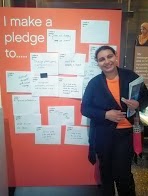By Phoebe Farag Mikhail
“Work with us.” That is what marginalized people around the world are asking, and it sounds unusual. We expect poor people to be asking for funds, for some wealthy “expert” quoting the Millennium Development Goals to swoop in and save them from their troubled lives, transforming them into comfortable, Western middle class lives. The research done by Participate has shown the opposite. Marginalized people want, most of all, to be able to tell their own stories and determine their own futures. They want and need help from others, but what they want is to be worked with, to be partners, not charity cases. “The people were so happy to be able to tell their stories,” Nusrat Zerin, a program officer from Sightsavers in Bangladesh told me. Sightsavers works to bring eye care to the poorest communities, and provide education to those who are already visually impaired. This desire for dignity was shown, in fact, to be more important than the need for economic resources.
 | |
| Mwangi Waituru, Kenya, and Nusrat Zerin, Bangladesh |
The result of this research is being toured in an interactive display in New York City this week and next in conjunction with the launch of the Participate report. Whether you’re interested in international development or not, a visit to this exhibition and its related events is worth your time. You can see the schedule here: http://workwithus2015.org/exhibition.html
At the exhibition launch this past Monday, I was able to learn about a sample of the different organizations and activities around the world through interactive displays that included videos created by the participants themselves using a process called participatory video. One such video showed a young woman in the West Bank preparing for a birthday celebration in her home, and getting phone call after phone call from friends who tell her they can’t make it because they are stuck at a checkpoint and did not know when they would be allowed to leave. The video was done with the organization Middle East Nonviolence and Democracy (MEND), which works to promote nonviolence and open media in East Jerusalem and the West Bank.
The Participate process isn’t just a learning event for the viewers. The participants all over the world, and the local researchers that worked with them, learned just as much. “When you live in a community or are from the community or are from the community,” Mwangi Waituru told me, “you think that you already know everything about it. But through this research process we discovered many things we didn’t know about ourselves.” Mwangi is responsible for policy research and advocacy at the Seed Institute in Nairobi, Kenya. Its Participate activity focused on raising the voices of vulnerable women and children in the Red Soil settlement using drawing, essay writing and film production.
 | |
| Phoebe in front of the pledge board |

No comments:
Post a Comment